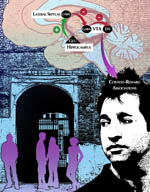|
Spotlight in the Lab
What
Imagine if actor Charlie Sheen were able to break the link his brain
makes every time he sees triggers in his environment that induce a
substance abuse relapse. He might still have his hit show and his wife.
In an article published in
the July 15 edition of Science, MUSC and National Institutes of Health
(NIH) researchers report the discovery of a new brain circuit that is
responsible for connecting contextual, or environmental, cues and
stimuli with the perceived reward for responding to those cues.
This discovery is
important for developing new therapies to treat recovering drug
addicts, people suffering from certain mental illnesses such as
schizophrenia, or people who live with learning disorders. It also
sheds light on the brain system responsible for allowing people to
adapt to changes in their environments over time.
 Graphic
provided by Emma Vought, Neurosciences Graphic
provided by Emma Vought, Neurosciences
Who
Gary Aston-Jones, Ph.D., MUSC neurosciences professor and the William
E. Murray SmartState Endowed Chair in Neurosciences, worked with first
author Alice Luo, Ph.D., on the project prior to her employment as a
researcher with NIH: "Context is important in all aspects of life.
Everything we do is guided by the context in which we find ourselves.
For example, the environment (or context) where a person previously
acquired drugs becomes a major trigger for relapse in addicts."
The
research
This new research shows how a part of the brain (the hippocampus, an
area of the brain responsible for recognizing and processing the
environment), links to the dopamine system (VTA), an area responsible
for "expectation of reward," via a relay called the septum. When the
hippocampus activates the VTA via this circuit, it directs people to
seek the reward they will get from the drug. For example, an addict
might typically go to a certain neighborhood to buy drugs and get his
fix. If he is in a similar neighborhood, a message is relayed from the
hippocampus to VTA, "Hey! Look where I am! I got drugs in a place like
this before! Go get a fix. Remember, a fix feels good, go get a fix..."
According to Aston-Jones, this circuit can relay this information to
the dopamine reward system very quickly and strongly. "In an
experienced addict, this can overpower other more normal behavior," he
said.
Using rodent models, Luo,
Aston-Jones and their colleagues inactivated the circuit by alternately
blocking the circuit's path in the hippocampus, septum or within the
dopamine system. Blockade of this circuit at any point decreased the
ability of a drug environment to cause drug-seeking in rats.
One of the parts of this
new circuit, the lateral septum, was a hot area of research in the
1950s because it was the first brain region found where electrical
stimulation caused strongly rewarding effects. This 'electrical brain
self-stimulation' phenomenon was discovered by James Olds, who was
Aston-Jones's first thesis advisor in the 1970s. The present research
was carried out by Luo who did her thesis work with Aston-Jones.
Another project conducted by student Greg Sartor in the Aston-Jones lab
also shows the lateral septum to be important in reward processing.
"Our research brings the septum full-circle," Aston-Jones said. "It
confirms Olds' observations and identifies the circuit it is involved
in to cause these reward effects."
Potential
The identification of this circuit shows researchers and clinicians
brain areas to target to treat addiction. For example, deep brain
stimulation (DBS, a procedure that neurosurgeons specialize in at MUSC)
turns off an area of the brain when it is administered. This research
indicates that DBS in the septum may be a new avenue for treating
intractable addiction to drugs or alcohol. This research may be
relevant to natural reward craving, such as what occurs for food in
some obese individuals.
For a copy of "Linking
Context with Reward: A Functional Circuit from Hippocampal CA3 to
Ventral Tegmental Area," visit http://www.sciencemag.org/.
|



 Graphic
provided by Emma Vought, Neurosciences
Graphic
provided by Emma Vought, Neurosciences